Have you ever wondered how a small piece of wood could redefine your entire guitar playing experience? As a seasoned luthier, I have spent countless hours crafting instruments and perfecting my art, and I have come to realize that something as unassuming as a guitar pick can make all the difference. Among the plethora of options available, wooden guitar picks have increasingly caught the attention of musicians. From enhancing tonal depth to adding a unique tactile feel, these picks offer more than just a traditional strum.
My journey with wooden guitar picks began when a fellow musician handed me a beautifully carved piece during a jam session, sparking a curiosity that would shape my expertise. In this guide, we will explore the multifaceted world of wooden picks, diving into their benefits, the various types you might encounter, and the reasons they have become a cherished part of many guitarists’ arsenals. Drawing from my decades of experience, let’s delve together into how such a small accessory can wield significant influence in your musical expression.
What are Wooden Guitar Picks?
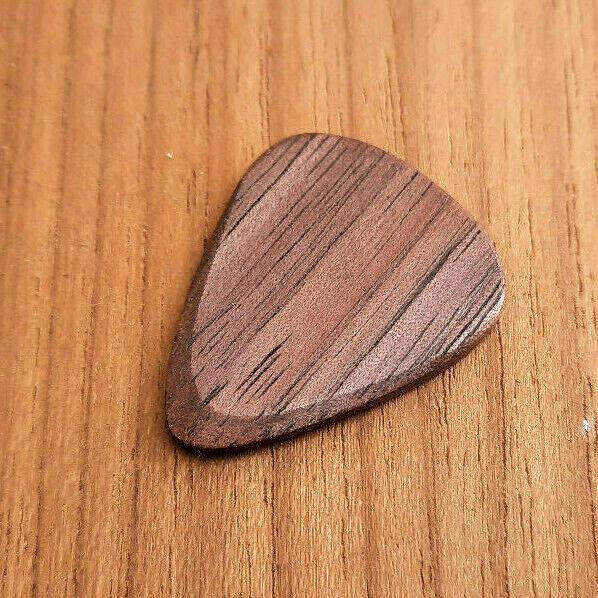
What if I told you that guitar picks can be as personalized as the instruments they play? During my years of crafting and making instruments, I’ve discovered that picks made from wood aren’t just another accessory—they are an extension of the musician’s soul. Wooden guitar picks offer a unique way to shape your sound and style, bringing a natural authenticity that complements the beauty of wooden guitars. But what exactly are these picks?
In essence, wooden guitar picks are crafted from a variety of hardwoods, each lending its own unique character to the music. The allure of these picks lies in their ability to not only enhance acoustic properties but also to provide a tactile connection that plastic or metal picks cannot replicate. The different types of wooden guitar picks—ranging from walnut to maple or even exotic woods like rosewood—each have distinct tonal qualities. For instance, a maple pick might produce a brighter, more articulated sound, while a rosewood pick can offer warm, mellow tones.
Throughout my journey into instrument-making, I’ve marveled at how a simple change in material can drastically influence one’s playing experience. The natural fibers in wood interact differently with guitar strings, offering musicians a distinct resonance with every strum, pluck, or pick.
Understanding these picks isn’t just about knowing their definition; it’s about embracing the subtle complexities and personal touch they bring to every performance. Dive deeper, and you’ll find that wooden picks are not merely tools but treasured companions on your musical journey.
Why Choose Wooden Guitar Picks?
Advantages of Wooden Guitar Picks

In selecting wooden guitar picks, their unique advantages are evident to anyone seeking a blend of sonic warmth and environmental consciousness. As someone deeply invested in sustainability and craftsmanship, I appreciate how these picks not only enhance my music but align with eco-friendly practices in lutherie. Wooden picks offer a natural timbre that softens attack, providing a rich, organic sound particularly suited for acoustic instruments. Their natural grip offers exceptional control, enhancing precision in playability.
In line with my commitment to environmentally responsible choices, I find wooden picks, crafted from sustainable sources, to be a compelling option. Their biodegradability further underscores their role in reducing plastic waste. As I explore various materials and types, the tactile and tonal differences with wooden picks consistently prove significant.
The alignment of sound quality and sustainability makes wooden guitar picks an appealing choice, naturally segueing into their occasional drawbacks and types. This consideration complements the holistic exploration of wooden picks throughout our guide.
Disadvantages of Wooden Guitar Picks

When it comes to wooden guitar picks, their distinct *aesthetic appeal* and *unique tonal qualities* are significant advantages; however, there are notable disadvantages of wooden guitar picks that every guitarist should consider. From my research into the physics of materials in instrument making, I’ve identified that wooden picks, while beautiful, require specific care and maintenance. Unlike their plastic counterparts, wooden picks can be prone to wear and tear and may not offer the same durability, often leading to shorter lifespans. This means they demand more frequent replacements, which can add up for frequent players. Additionally, the tonal variation attributed to different wood types can be both a blessing and a curse, as it may result in inconsistent sound production across different pick sources. Hence, the choice between wooden vs plastic guitar picks hinges greatly on a player’s emphasis on tone versus practicality as discussed in the next section about Types of Wooden Guitar Picks.
Types of Wooden Guitar Picks
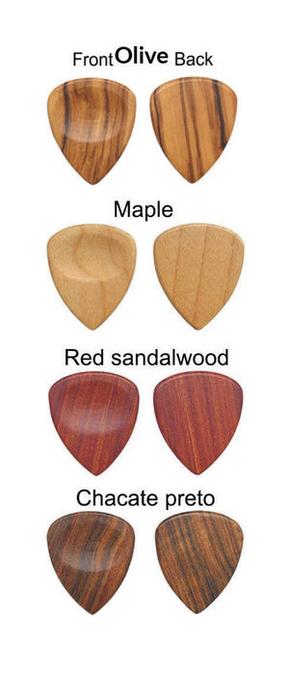
As I’ve delved into various types of wood for instrument making, I’ve found that each species contributes unique tonal qualities, making wooden picks a diverse choice. Did you know that the type of wood used for your guitar pick can drastically alter your sound? This realization hit me during one of my early explorations of wooden guitar picks, where I experimented with a range of woods, each revealing its distinct character through tone and texture.
Most notably, picks made from rosewood provide a *deep and warm* sound, reminiscent of traditional acoustic guitar vibe, whereas picks crafted from ebony are prized for their *bright and crisp* tonal qualities, perfect for players who favor clarity and articulation above all. Then there’s mahogany, known for its warm tones that blend especially well across a variety of music genres, offering a balanced sound that’s neither too sharp nor too mellow.
In contrast, maple picks deliver a more subtle yet distinctly softer tone, ideal for those seeking a more understated sound signature. These nuances in tone and feel demonstrate why custom wooden guitar picks have gained popularity among musicians who want to tailor their sound precisely to their musical style.
For me, this diversity in tonal characteristics opened up new avenues to personalize my music, allowing me to match the pick’s attributes to my evolving artistic expression. It’s fascinating how these seemingly small choices can make such a significant impact.
How to Make Wooden Guitar Picks
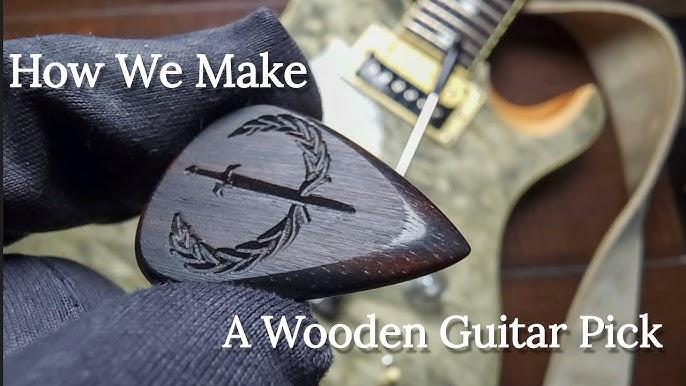
Have you ever considered crafting your own guitar pick for a truly personalized experience? As someone who has spent years mastering the art of lutherie, I can assure you that making your own guitar pick not only enhances your connection to your instrument but also deepens your understanding of material properties. The journey from raw wood to a smooth, playable pick is both exhilarating and deeply satisfying.
The first step in how to make wooden guitar picks involves selecting the right wood selection for guitar picks. Different woods convey varying tonal qualities. For instance, harder woods like maple or ebony produce a brighter sound, while softer woods like mahogany offer a warmer, mellower tone. Consider what complements your playing style and target sound.
Once you’ve chosen your wood, the next step involves preparing your materials. Cut a small, flat piece of wood, roughly the size of a credit card. Using a stencil or freehand, trace the shape of your desired pick onto the wood. A classic teardrop shape works well, but feel free to experiment with sizes and designs that feel comfortable in your hand.
With the shape outlined, use a small coping saw to carefully cut out your pick. This might be new territory, but precise cuts are essential. After cutting, gradation is key, so sand the edges and surfaces thoroughly. Begin with coarse-grit sandpaper to remove any saw marks, and gradually move to a finer grit for a smooth, polished finish.
Don’t forget the finishing touch. A thin layer of natural oil or wax not only protects your wooden pick but also brings out the wood’s natural beauty. Remember, a well-crafted pick should feel like an extension of yourself when you play.
Crafting your own wooden guitar pick is more than just a project; it’s a rewarding endeavor that fosters a deeper appreciation for the nuances of lutherie. Whether you stick with classic designs or create custom shapes that only you can call yours, the process is a delightful blend of artistry and music.
Recommendations and Reviews
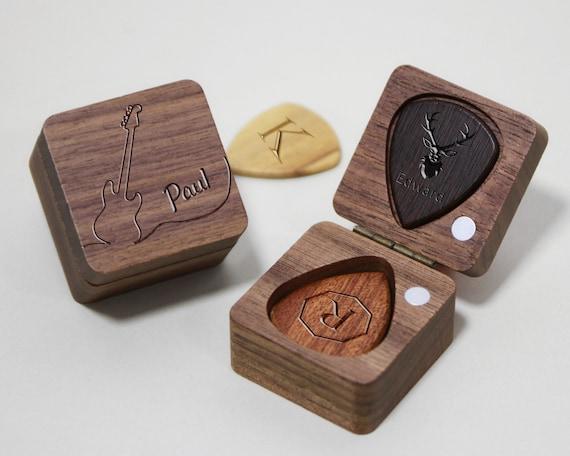
After years immersed in the intricate world of stringed instruments, I’ve developed a keen eye—and ear—for what sets apart the best wooden guitar picks. The artistry and acoustic elegance of these picks can transform a guitarist’s sound and playing experience. With my editorial work in the field, I’ve had the privilege of evaluating numerous options to discover which ones truly excel in craftsmanship and sound quality.
What are the most sought-after wooden guitar picks among experienced musicians? This question is pivotal when navigating the myriad choices available today. Among seasoned players, picks made from rich woods like maple, ebony, and rosewood tend to make the cut. Their natural density and texture offer a unique tonal quality that synthetic picks often fail to achieve.
In my reviews, I find that picks crafted by smaller, artisanal makers often stand out due to their attention to detail and unique wood combinations. For instance, Timber Tones and Wegen Picks frequently appear in recommendations for their ability to produce warm, nuanced sounds—perfect for both mellow jazz tunes and intricate classical pieces. These brands are lauded not just for their sonic performance but also for the ergonomic comfort they provide, integrating the art of pick-making with the science of sound.
Ultimately, the charm of a wood guitar pick lies in its ability to connect the musician with the organic vibrations of the wood, adding a layer of authenticity to every chord strummed. My advice is to try a few different types, as the perfect pick will feel like an extension of your own hand, complementing your unique musical style. This exploration amplifies not just music but also the joy of crafting it.
Personal Experiences
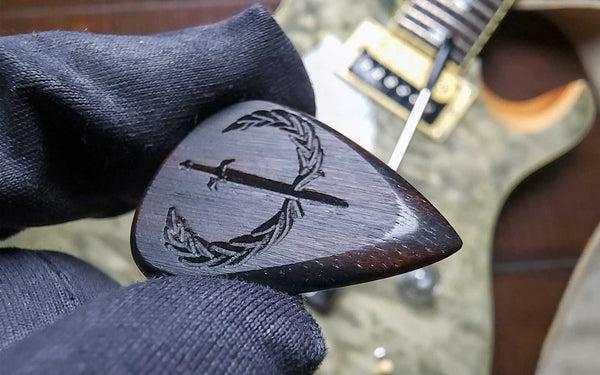
Through years of playing and experimenting, I’ve learned that the right pick can influence not only tone but also the nuances of my picking technique. When I first stumbled upon wooden guitar picks, I was skeptical. Could a piece of wood really make such a difference? My journey began with a simple curiosity sparked by a friend’s testimonial, and soon after, I ventured into a world of guitar pick comparison.
How has my experience shaped my understanding of the perfect guitar pick? This question became a guiding force as I experimented with various woods, each offering distinct tonal qualities. I discovered that softer woods provide warmth and mellowness, while harder types deliver crisp, articulate sounds. This informed experimentation revealed that the density and texture of each pick could subtly influence my picking dynamics, shaping both my sound and technique.
One autumn evening, amidst a flurry of chords and melodies, I realized how the right wooden pick can feel like an extension of my own hand. This deeply personal realization affirmed what I’d heard from others, but now it resonated as my own truth. Each strum felt more expressive, each note more alive, revealing nuances in my playing that I hadn’t noticed before. It isn’t just about altering sound but fine-tuning style, which is why I now reach for my wooden picks every time I play. These insights have enriched my musical journey, aligning with both my fingers’ intent and my guitar’s voice.
FAQs
What are the benefits of using wooden guitar picks?
What types of wooden guitar picks are available?
How do wooden guitar picks compare to traditional picks?
Can wooden picks be used with electric guitars?
How should I care for my wooden guitar picks?
Conclusion
Could the future of guitar accessories lie in sustainable choices like wooden picks? Reflecting on my journey in lutherie, I firmly believe that as we strive for better sustainability in music, wooden picks represent a harmonious blend of tradition and eco-conscious innovation. Having explored what wooden guitar picks are and the myriad reasons to choose them, it’s clear they offer a unique sound and an intimate connection with our instruments that few other materials can match.
Through understanding their advantages, such as their warm tonal qualities and eco-friendly nature, alongside potential disadvantages like durability concerns, we’ve seen that these picks provide a distinctive option for dedicated musicians. From the various types to how-to guides on crafting them, it’s evident that wooden picks are more than accessories—they are an extension of our artistic expression. Supported by positive reviews and personal experiences shared throughout, wooden picks invite us to rethink how sustainable practices can enhance our musical journey.
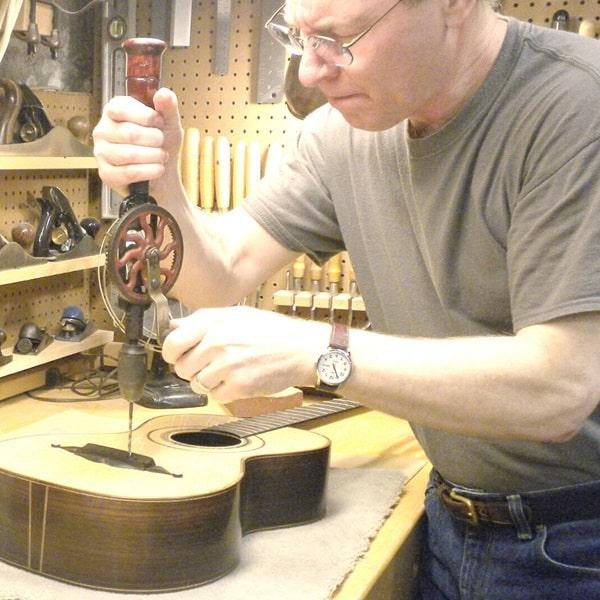
R.M. Mottola, an engineer-turned-luthier, revolutionizes stringed instrument design with his deep focus on acoustics and ergonomics since 1994. As editor of the Savart Journal and a key contributor to American Lutherie, Mottola merges science with artistry in lutherie. He enriches the field with his extensive knowledge, shared through his Liutaio Mottola website, making him a beacon in the world of modern instrument craftsmanship.
